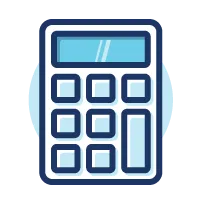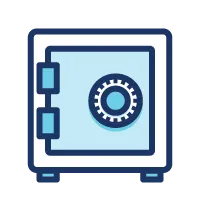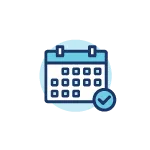What We'll Cover
- How to create an emergency fund
- Saving for holiday shopping, vacations and other personal desires
- How much to save for retirement
- A budgeting formula to help you save more money
Did you know that a recent study found that 125 million U.S. adults are currently living paycheck-to-paycheck? To put this into perspective, over half of the adults in the United States are one-missed paycheck away from financial disaster.
Saving money from each paycheck is a great solution for those facing this uncertainty.
But how much of my paycheck should I save?
Before asking yourself how much you should be saving, start by defining what you are saving for.
Saving For Emergencies
If you’ve found yourself living paycheck-to-paycheck, then you know the stress of the next large bill or the unexpected financial emergency.
In fact, when money is the root cause of stress in your life, then every little financial hiccup becomes a financial disaster.
You need to start saving to create a buffer between you and the next financial emergency. The amount of money you need to save when it comes to preparing for financial emergencies will vary from person to person, but a good rule of thumb is three-to-six months’ worth of emergency expenses.
The Emergency Fund
You probably just read three to six months’ worth of emergency expenses and thought to yourself:
I am living paycheck-to-paycheck, how can I afford to save three-to-six months’ worth of emergency expenses?
Let’s not worry about that three-to-six months’ worth of emergency expenses right now. Instead, let’s focus on saving $1,000 as quickly as possible.
Need some help saving $1,000 as quickly as possible? Here are a few ideas to jumpstart your savings goal:
- Scrape your budget - Look through your monthly budget and find the wants versus the needs. It’s okay to push pause on some of the wants in life to fulfill a need. In this case, you may want to go to a nice dinner, but you need to build your $1,000 emergency fund first.
- Sell something - You can always go back and buy that one thing again, but right now the number one priority is to get to $1,000 as quickly as possible. Go through your belongings and if you want them but don’t need them, then it’s time to sell them.
- Pick up a side job - The good news is there is work out there for you to generate extra income. Maybe that is becoming a rideshare driver, delivering pizzas, or getting a part-time job somewhere. Remember, this isn’t a career change, this is just a way to generate extra income.
The truth for many of us is that it feels like saving money is impossible. However, once you quickly hit that $1,000, then saving up to $2,000 seems possible.
And once you save $2,000, then $4,000 doesn’t seem out of reach. After you’ve saved $4,000 - $5,000, the belief you cannot save money evaporates and you develop a habit of saving.
Now, after you’ve hit your goal of saving for that emergency fund it’s time to start saving for something else — something much more enjoyable.
Saving for Stuff
We live in a world of buy now, pay later. Or even worse — buy now, pay later, and pay forever!
Instead, the better way to buy stuff is to save up first and then make your purchase.
Maybe it’s something you want at your favorite store or a trip you have been dreaming about for years. Either way, it’s important to know that saving for stuff is a good thing!
Whatever you’re saving for, it’s important to identify what that goal is and then determine how long versus how much you are willing to save for it.
A great example is holiday shopping. The holidays come around the same time each year, but so many of us forget to save for the holiday shopping season and end up carrying debt from our holiday spending well into the summer months.
This is a great opportunity to become intentional about saving for the holidays. For example, let’s assume you set your holiday budget at $1,200. Starting in January, set aside $100 from your paycheck every month and when Black Friday arrives, you will already have most of the money in hand.
You can repeat this process for any other stuff you want. Maybe it’s a vacation you plan on taking next year, a car you want to buy in three years, or college tuition that is down the road.
Whatever stuff you are saving for, make sure you identify it, plan for it, and save for it.
Saving for Retirement
Once you have built your emergency fund to that three-to-six months’ worth of emergency expenses, it’s time to save for your future.
Most financial experts will advise you to start saving anywhere between 10% and 20% of your paycheck into a retirement account.
The greatest thing about saving for retirement is the money you are saving will go to work for you in the form of compound interest! Think of this as “interest on interest.” This is where the savings you set aside generates money in the form of interest that’s added to your savings, which over time generates more interest. That means more money for you to enjoy into retirement.
Compound interest is the 8th wonder of the world. He who understands it, earns it. He who doesn’t, pays it.
I Would Rather Have an Exact Amount to Save from My Paycheck
If you are looking for a black and white answer to the question of how much you should be saving from your paycheck, then you may like the 50/30/20 budget.
The 50/30/20 budgeting system divides your paycheck into three different categories:

-
50%for the needs in your life
-
30%for the wants in your life
-
20%for savings
While this is a very simple and straightforward way of budgeting, it may not work for everyone. For example, someone who is living paycheck-to-paycheck and deeply in debt can’t afford to spend 30% of their paycheck on their wants in life.
Also, 20% savings may feel like a great number, but what if you’re struggling to save any money at all, how is it possible to start saving 20%?
The flip side of that is to ask how does all the savings fit into 20%? For example, if 15% is going into retirement, then that only leaves 5% leftover to save for all the other things you still need to save for.
Key Takeaways
- A good rule of thumb is to save three-to-six months’ worth of emergency expenses.
- Whatever you’re saving for, it’s important to identify what that goal is and then determine how long versus how much you are willing to save for it.
- Most financial experts will advise you to start saving anywhere between 10% and 20% of your paycheck into a retirement account.
- The 50/30/20 budgeting system means you put 50% of your income toward the needs in your life, 30% toward the wants in your life, and 20% toward savings.
How to Start Saving and Never Stop
Once you start saving money from your paycheck each month, it will develop into a habit. And once you create a savings habit, you will continue to save money.
The best way to create a saving habit is to create a monthly budget. As the saying goes, what gets measured also gets managed.
If you have never created a budget before, here are 7 steps to creating a simple budget.
Once you have created your budget and intentionally set money aside in your monthly budget for savings, the savings becomes automatic.
Chris “Peach” Petrie is the founder of Money Peach. Money Peach partnered with OneAZ to provide free financial education to members across the state. To learn more about OneAZ’s partnership with Money Peach, click here.
APR = Annual Percentage Rate














